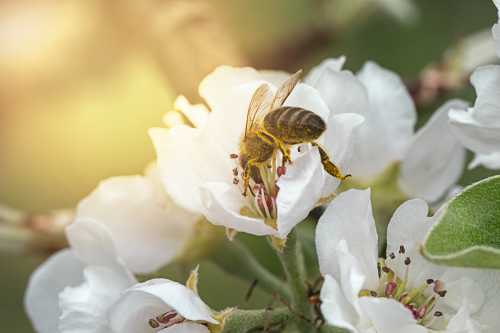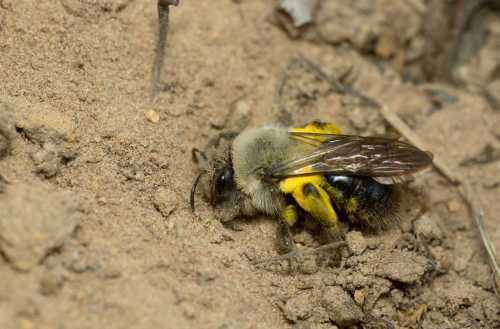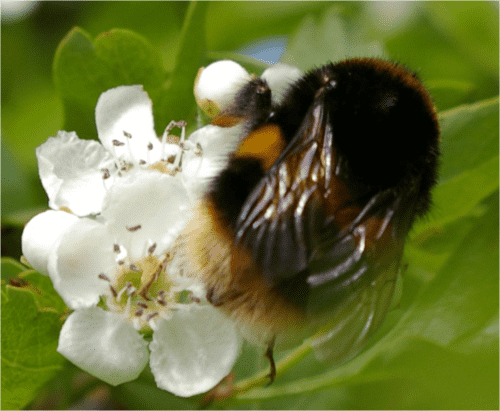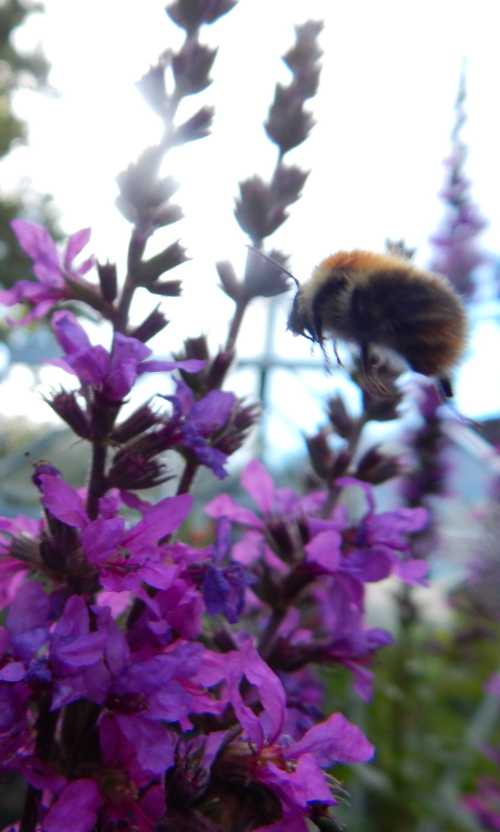The Foraging Range Of Bees
Research Papers Investigating Foraging Distances Of Bees
There are a large number of research papers investigating the foraging range of bees, albeit mostly for honey bees, some for bumble bees, and comparatively few for solitary bee species.
Scientific Research Papers
Below is a list of research papers and a very brief summary, but more research into the foraging range of bees can easily be found over the internet.
Foraging Range Of Honey Bees

- Frisch, Von K. (1967) The Dance Language and Orientation of Bees. Harvard University Press, Cambridge, MA.
The foraging range of honey bees was recorded to reach up to 13·5 km. - Visscher, P.K.
& Seeley, T.D. (1982) Foraging strategy of honeybee colonies in a temperate
deciduous forest. Ecology 63, 1790 1801.
Demonstrated that honey bees (Apis mellifera) regularly forage several kilometres from the nest.
Most frequently, honey bee workers were observed to fly 600–800 meters to collect food.
The mean was 2·3 km and 9% of the colony’s foraging was within a radius of 6 km, but foraging activity depended on the abundance of profitable forage available.
- Waddington, K.D., Visscher, P.K., Herbert, T.J., Raveret Richter, M. (1994) Comparisons of forager distributions from
matched honey bee colonies in suburban environments. Behavioral Ecology Sociobiology 35, 423 429.
Observed foraging range was 745–1413 metres.
The mean distance was 534–1138 metres, depending on the hive and location. - Schneider, S.S.
(1989) Spatial foraging patterns of the African honeybee, Apis mellifera
scutellata. Journal of Insect Behaviour 2, 505 521.
In the African Honey-bee, Apis mellifera scutellata, the mean foraging distance was 1200 metres. - Schneider, S.S.
& Hall, H.G. (1997) Diet selection and foraging distances of African and
European-African honey bee colonies in Costa Rica. Insectes Sociaux 44, 171
187.
Mean foraging distance for African colonies was 1073 metres, and for the hybrid colonies the mean foraging distance was 1387 metres.
- Beekman, M, Ratnieks, F. L. W. (2000) Long-range foraging by the honey-bee, Apis mellifera L. Functional Ecology Volume 14, Issue 4.
Waggle dances of honey-bees (Apis mellifera L.) were decoded to determine where and how far the bees foraged during the blooming of heather (Calluna vulgaris L. The median distance foraged was 6·1 km, and the mean 5·5 km.
Only 10% of the bees foraged within 0·5 km of the hive whereas 50% went more than 6 km, 25% more than 7·5 km and 10% more than 9·5 km from the hive.
Foraging Range Of Solitary Bees
- Gathmann, A. and Tscharntke, T. (2002), Foraging ranges of solitary bees. Journal of Animal Ecology, 71: 757-764.
This 2002 study found the maximum foraging distance between nesting site and food patch was 150–600 m for the 16 solitary bee species included in the study.
The researchers suggest that solitary bees have a small foraging range, emphasizing the importance of local habitat to these species.
Below is an adapted table from the study, detailing the foraging ranges of the 16 species.
| Species | Foraging distance (m) | Reference |
|---|---|---|
| Andrena barbilabris (Kirby) | (a) 500 (b) 300 | (a) Witt (1992), (b) Wesserling (1996) |
| Andrena cineraria (Linnaeus) | 300 | Gebhardt & Röhr (1987) |
| Andrena clarkella (Kirby) | 300 | Gebhardt & Röhr (1987) |
| Andrena flavipes Panzer | 260 | Wesserling (1996) |
| Andrena vaga Panzer | 260 | Wesserling (1996) |
| Chelostoma florisomne (Linnaeus) | 150 | Kapyla (1978) |
| Chelostoma rapunculi (Lepeletier) | 200 | Gathmann (1998) |
| Colletes cunicularis (Linnaeus) | 350 | Wesserling (1996) |
| Megachile lapponica Thompson | 600 | Wesserling (1996) |
| Megachile rotundata (Fabricius) | (a) 500 (b) 100 | (a)Tepedino (1983), (b)Tasei & Delaude (1984) |
| Osmia anthocopoides Schenk | 150 | Molitor (1937) |
| Osmia maritima Friese | 150 | Haeseler (1982) |
| Osmia mustelina Gerstaecker | 1000 | Molitor (1937 ) |
| Osmia rufa (Linnaeus) | 600 | Gathmann (1998) |
| Pangurus banksianus (Kirby) | 250 | Münster-Swendsen (1968) |
| Tetralonia salicariae (Lepeletier) | 400 | Molitor (1936) |
| Xylocopa violacea (Linnaeus) | 1200 | Molitor (1937) |
 Grey backed mining bee Andrena vaga
Grey backed mining bee Andrena vaga- Goulson in Bumblebee Behaviour And Ecology (page 73) writes a
few sentences on the foraging behaviour of solitary bee:
“Little is known of the foraging range of most other bee species, but those estimates that are available suggest that honey bees are unusual, and that most bees forage over much shorter distances.
For example, Melipona fasciata travels up to 2.4km (Roubik and Aluja 1983) and members of the Trigonini over 1 km (Roubik et al. 1986).
Solitary bee species are generally thought to travel only a few hundred metres at most (Schwartz and Jurst 1997). The maximum recorded foraging distance is 24km for euglossine bees (Janzen 1971).”
- Janzen, D.H.. (1971) Euglossine bees as long distance
pollinators of tropical plants. Science 171, 203-205.
Euglossine bee, Euplasia surinamensis, was able to return home from a distance of 23km. Some of the bees returning from distances as far as 14, 12, 20 and 23km, returned with full pollen baskets, which of course indicates foraging.
Foraging Range Of Bumble Bees
- Dramstad (1996). Do bumblebees (Hymenoptera: Apidae) really
forage close to their nests? Journal of Insect Behavior Vol 9, 2, 163-182
Three experiments are described that involved the marking and observation of bumble bees. None of these experiments showed any tendency for bumble bees to concentrate their foraging close to the nest (e.g. within 50 m).
The results suggested that bumble bees may prefer to forage at some distance from their nest, although searches up to 300m located very few marked bees.
 Buff-tailed bumble bee, Bombus terrestris
Buff-tailed bumble bee, Bombus terrestris- Stephan Wolf,
Robin F.A. Moritz Apidologie
39 (2008) 419–427. Foraging
distance in Bombus terrestris L. (Hymenoptera: Apidae)
A study which again using marked bees. The mean foraging distance of B. terrestris workers was 267.2 m ± 180.3 m (max. 800 m). Nearly 40% of the workers foraged within 100 m around the nest.
It is postulated that B. terrestris workers have thus rather moderate foraging ranges, if rewarding forage is available within vicinity of the nests.
They state that spatial distribution and the quality of forage plots were the major determinants for the bees foraging decision-making, explaining over 80% of the foraging frequency. - Ben Darvill,
Mairi E. Knight and Dave Goulson 2004 Use of genetic markers to quantify bumblebee foraging range and nest
densit. OIKOS 107: 471
478.
B. pascuorum foraged over distances less than 312 m and B. terrestris less than 625 m. They propose that bumble bee species differ greatly in fundamental aspects of their ecology.
- (Brochure): Conservation
and Management of North American Bumble Bees
by Dale F. Schweitzer, Nicole A. Capuano, Bruce E. Young and Sheila R.
Colla; USDA Forest
Service and NatureServe
Downloadable on this link: http://www.fs.fed.us/wildflowers/pollinators/
documents/ConsMgmtNABumbleBees.pdf
"Although some bumble bees can forage up to several kilometers from their colonies in search of nectar and pollen, most species probably travel no more than 600-1,700m (1/3- 1mi) to forage (Dramstad 1996, Hines and Hendrix 2005, Droege 2008, De Vore 2009). Presumably shorter foraging trips are both safer and more energy-efficient.
The desert subspecies B. pensylvanicus sonorus can ascend as much as 1,000 vertical meters (0.6mi) on a daily basis in search of food (Schmidt And Jacobson 2005)".
Methods Used To Measure The Foraging Range Of Bees
Gathering reliable and meaningful data is not necessarily easy! A look at some of the research methods used to measure the foraging range of bees can be found on the page how far do bees fly for food, and why this question is important.
If you found this page helpful or interesting, I'd really be grateful if you would share it with others - if not this page, perhaps another, such as Gardening For Bees.
Thank you so much :) .
